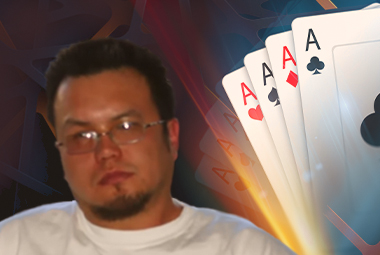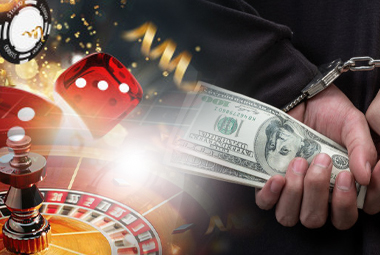INTRODUCTION
I’ve recently stumbled upon a Youtube video called, “Las Vegas: The Cat and Mouse Game-Cheating Vegas,” which I will link to here:
This video is brought to us by a documentary channel called, “TRACKS,” and has nearly 200,000 subscribers as of the time of this writing, so I decided to do a review so you can decide if the nearly 48 minutes is worth your time.
I should also mention that this documentary was very likely on TV, at some point. I believe this for two reasons:
- According to the video description, TRACKS licensed the rights to this from an entity called CINEFLIX.
- The length is about right for an hour long TV program with four three-minute sets of commercial breaks.
I almost never watch TV, though, but as you might expect, my Youtube recommendations frequently include gambling-related videos.

WHERE’S THE CHEATING?
The first thing I would want prospective viewers to know is that the title is pretty misleading, at least, if you’re somewhat gambling savvy. When I think of casino cheating, I think of past posting, marking cards, collusion, etc. etc.
The different segments covered in this include:
- Counterfeit Casino Chips
- Straight Armed Robbery
- Dealer Collusion (Finally, Cheating!)
- Slot Tampering
We’re going to go ahead and break each section of this down for this review, followed by my thoughts on each section. I’m going to give warning now that there ARE SPOILERS AHEAD, in fact, I’ll basically be saying what happens in each segment.
Erik Morikawa and Jeremy Lewis
The first section of the video deals with Erik Morikawa and Jeremy Lewis, two then construction workers who figured out a way to counterfeit casino chips.
Construction projects had dwindled in the Vegas area when Erik Morikawa drove past a casino billboard (featuring a high-denomination chip) and came up with the idea that chips ARE money to a casino and should be easier than money to counterfeit.
The original idea was just to straight up make counterfeit casino chips. Eventually, Morikawa, Lewis (and a handful of others) determined that it was hard to get the precise composite substance right that casino chips are made of. Casino chips are made of a unique combination of elements resulting in a particular weight, feel in the hands...and, of course, that light clacking sound that every table/poker player is so familiar with when dropped or clicked together.
The individuals working on the project became increasingly frustrated, particularly when they could match the weight but not get the chips to make the right sound. Honestly, it probably would have taken a chemist to reverse-engineer the precise composite of substances needed...not to mention the conditions needed to press them appropriately.
With exception to Morikawa and Lewis, all involved got frustrated and gave up on the venture. The remaining pair eventually hatched a plan to the extent that chips would be easier to modify than create from nothing. After all, it was creating the physical chip base that presented the biggest problem.
You can watch the video for yourself if you want more details, but eventually, the pair discovered that it was not difficult to get the inlay marking the casino and denomination out of the chips to be replaced with a new one. The new inlays were a simple matter of scanning them into a computer and printing them out on paper lined with plastic, then you basically just glue them in place. The question then became one of changing the physical chip itself.
Much like the inlays themselves, the colors were easy for a, “Close enough,” type match by trying different color combinations out and seeing what came out. They at least got them to the point that they would pass in low casino light as long as the chips weren’t examined ridiculously closely...and what casino employee has time to look at chips under a magnifying glass? You basically just needed the chips to be passable to the naked eyeball.
One problem was that some casinos had designs that would appear only under a black light. It turned out that these designs were relatively reproducible using only glow in the dark art supplies. Secondly, these designs seemed to be randomly positioned on the chips, (at least, for this casino) so that eliminated any need to have the location of the watermark be passable...it could basically be anywhere in the inlay.
The pair started off with three $100 chips that they were able to pass off at the cage easily enough. According to the documentary, they were able to convert some twenty chips per day from $1 denomination to $100...or whatever else they wanted.

They decided to go with, “Whatever else.”
Eventually, they reached the point where they were counterfeiting denominations as high as $1,000 chips. They ultimately decided that just coming in and cashing chips was going to look fishy, so they made the decision to, ‘Wash,’ the chips by cashing them in at table games and giving a little play. You might ask yourself: What’s the difference between going to the cage with unexplained chips and going to a table with unexplained high denomination chips?
At least, I asked myself that.
We now reach the point where, “Consider the source,” becomes important as the documentary only really talks to Morikawa and not Jeremy Lewis. Basically, Morikawa was living more-or-less in an under the radar way other than some lavish purchases outside of casinos. In the meantime, according to Morikawa, Lewis was partying it up in casino suites to the tune of several hundred dollars a light surrounding himself with ladies.
Eventually, Lewis would basically spill the beans on the operation to one of these ladies of questionable repute, whereas, Morikawa did not even disclose the source of this newfound money to his wife...not that she wanted to know.
This resourceful young woman would eventually blackmail the pair for money in exchange for not blabbing about their capers. As with most forms of blackmail, it started off reasonably small and got bigger. The problem with blackmail on an event like this is that it is information-based blackmail that does not involve a physical item...such as a videotape.
In other words, the dirt never disappears. You give the blackmailer money, but the blackmailer still has something on you.
The boyfriend of the blackmailer eventually found himself in some trouble, and apparently, this young lady was able to roll on the pair in order to help him out. It’s not really made clear what one situation had to do with the other.
Bail for the pair was initially set at five million bucks, but later reduced to $12,000. During his time in jail, Morikawa would become acquainted with some other criminal types who he agreed to teach how to do what he did in exchange for a cut.
Morikawa would be caught again later on down the line and would be sentenced to five years of probation and to make restitution of $36,000. This was quite a deal considering Morikawa places the total in counterfeit chips cashed at about a million dollars.
From this, RFID (Radio Frequency ID) chips would make their way into casino chips so that they can at least be tracked until they leave the casino. Counterfeit high-denomination chips would either not have such a chip at all, or will have one that doesn’t match up quite right.
TAKEAWAYS FROM THIS SEGMENT
- The first thing that we have going on is greed. They may well still be cashing $100 counterfeit chips to this day if they had been reasonable, spread it around and were willing to somewhat limit their weekly/monthly take. People travel to Vegas with tens of thousands of dollars with some frequency, so for most casinos, no cage is going to bat an eye at a couple or three hundred dollar chips.
- I think that the pair also, “Outsmarted themselves,” because washing the chips by playing game seems completely unnecessary...particularly so if they had just stuck to hundreds. In my opinion, this just adds time in the casino and results in more people physically dealing with the chips than does simply cashing them at the cage. It was also noticed by at least one dealer that a few of the chips didn’t look quite right in the rack.
- I don’t recommend committing crimes at all, but if you insist, then keep your operation small and don’t tell anyone outside of the operation about it. Blackmail is forever. It’s not like someone with information that could hypothetically put you away for years is going to disappear for $500 never to be seen again. You pretty much have to accept that you’re going to be paying them forever, or...well, let’s not go there.
- Keep your spending on the lowdown. Seriously. Buy groceries, or something. Here you have a couple of basically out of work (or limited work) construction workers suddenly making bank. It’s one thing to just live day-to-day life without being able to explain yourself, but dropping a thousand bucks a day partying and being a known personage just isn’t going to fly.

ANTHONY “TONY” CARLEO
That brings us to the second segment of the documentary, which deals with Anthony Carleo, “The Biker Bandit.” This segment has nothing to do with any kind of cheating; the events in question involve straight up armed robbery.
The advantage (not in the gambling sense) that Carleo had, at least at Suncoast Casino, is that the casino staff were unarmed. Concerned with employee safety (and legal liability) the policy of that casino was, and likely still is, just to let someone robbing the cage have the money. Another advantage that Carleo had was that the casino cage was about ten seconds from an exit.
Carleo, with motorcycle helmet and visor, walked into the Suncoast Casino and robbed the cage at gunpoint. That’s it. Would you call a bank robbery, “Cheating at the bank?” I wouldn’t. I don’t see what this has to do with casino cheating.
Carleo would commit his second robbery just five short days later.
Carleo would go on to rob the Bellagio (!?), though he would encounter an unexpected problem. The problem is that the cage was nowhere near an exit, and one key part of his plan was a quick in and a quick exit---hence the motorcycle. With that in mind, Carleo would instead opt to rob one of the tables of $5,000 and $25,000 chips...good as cash if you’re in Vegas.
The RFIDs were in place by this time, the problem being that they only worked inside of the casino. That was (temporarily) a darn good thing for Carleo, otherwise, they could have followed him right home.
I don’t know if you’ve ever heard the phrase, “Never return to the scene of the crime,” but Carleo not only did that--he made himself a very welcomed guest at the scene of the crime. Carleo states that he intended to only grab $5,000 chips, or less (still seems arbitrary), but accidentally ended up with a bunch of cranberries, as well. That would become a serious problem as Bellagio opted to discontinue the denomination.
Carleo would state that he became quite the prolific poker player at The Bellagio, routinely losing anywhere from $70,000-$100,000 per night. He would state that, even though the chips had been stolen anyway, the losses still hurt.
Unbeknownst to Bellagio, they would turn the other cheek by making Carleo a heavily comped player, extending to him an Executive Suite and other perks.
We also learn about Carleo, hardly a career criminal, he was the son of a judge in Las Vegas as well as a one-time student of UNLV who intended to become a physician. Eventually, he would develop a gambling problem and found himself involved in all sorts of things as, even then, he was gambling way too frequently and way too over his head. The, “Biker Bandit,” plan...if it can really be called that...was hatched basically out of necessity.
Carleo intended to throw away the, “Cranberry,” $25,000 chips as they had become impossible to cash or exchange for lower denomination chips. Instead, he decided to sell them online for $10,000 apiece.
Can you imagine?
Has anyone ever thought, “I’m going to willingly take a $15,000 haircut on these casino chips to get someone else to cash them because going back to Vegas is too much of a hassle?” The closest thing I’ve ever had to that is I’ve been straight up given a few (low value) chips to a casino for free because I was already going there. I think I also paid $50 for about $100 in chips once, just because the casino in question was about six hours away and I was already planning to go there.
But, even worse, Carleo was still in Las Vegas!!!
So, is that the dumbest thing ever?
Not yet. He advertised himself as, “The Biker Bandit,” in promoting the sale.
Naturally, he was caught. One funny thing was a Gaming Enforcement employee was interviewed and basically said if someone thinks they can rob a casino without getting caught they are, “Sadly mistaken.”
Um...yeah...,if you think you can rob a casino, and advertise that you did it, without getting caught, you’re sadly mistaken. He’d have probably gotten away with the Suncoast robbery, in my opinion.
TAKEAWAYS
1. This is another tale of greed and also going back to the criminal cookie jar one too many times. I’m reminded of an episode of a documentary series, “I Almost Got Away With It,” actually a few episodes...of bank robbers who had really solid plans and eventually just got themselves caught because of volume.
One just did it too many times and the other had a reasonably unique car that became known...they caught the second guy because they knew he was casing a particular bank before he even did it.
2. More greed with trying to sell the chips after they had been taken out of circulation.
Imagine going into a stockroom at WalMart and stealing exactly 37 Toshiba TV’s, then going online only days later and advertising that you have as many as 37 Toshiba TV’s for sale. The only way Carleo could have made himself easier to catch would be by going to the nearest police station and confessing his crime.

3. Don’t return to the scene of the crime. Especially don’t return to the scene of the crime with evidence of your guilt. I can’t even believe he managed to get away floating the 5k chips all over the place. He really should have been caught much earlier.
4. At least the Suncoast robbery was technically a plan. It wasn’t a great plan and it counted on a lot of potential variables not to happen...but it was a plan. He didn’t plan at The Bellagio, he decided he wasn’t going to waste his precious time walking in without stealing something and improvised.
5. DON’T TALK!!! If you must commit armed robbery, and I cannot emphasize enough how strongly I believe you shouldn’t, maybe don’t tell literally the entire Internet about it and lead them directly to you. Just a thought.
JAMES SHEHADY
In the third segment, we get into a crime that at least directly involves a casino game and cheating!
The segment does a reasonable job of explaining the rules of Pai-Gow Poker, at least, to the extent they are relevant. Relevantly, there is a high hand and a low hand, the low hand consists of two cards (and cannot be better than the high hand) and the high hand consists of the best five card poker hand. If the player and dealer both fail to win both hands, then the result is a push. The dealer also wins if both hands are a tie, but that’s quite rare.
At the Hard Rock Casino, under the alias, “Clifton Burton,” James Shehady was a relatively well-known Pai-Gow Poker player to the casino. He was so well-known, in fact, that it was noticed that he never lost on Sundays. Any other day...you guessed it...he wasn’t quite as lucky.
This determination was made just by way of player tracking, which made the casino pretty suspicious before the cheat was out.
The cheat was collusion between Shehady and a five-year tenured dealer who otherwise had a pretty good record as an employee. It’s tough to know for sure, but the documentary lends you to the assumption that he literally never lost any hands.
The way it would work is the dealer would do a, “Quick Spread,” of the high hand after Shehady indicated to the dealer (via some hand or high motion) that he was beat. The quick spread was done in such a way that the dealer’s hand largely obscured Shehady’s high hand from camera view...and was also done quickly so it would have to be watched back anyway even if all the cards were visible in a frame.
Winning hands win, pushes push, loses push...sounds like a game I would like, if not for the whole straight up theft thing.
As far as the cheat itself went, the casino manager received an, “Anonymous Tip,” that there was a player colluding with the dealer in order to defraud the casino.
PLOT TWIST: The anonymous tip came from the dealer who was just trying to get out from under Shehady’s thumb. Shehady had given the dealer the (false) impression that he had connections to organized crime and that the dealer would very likely have an, “Accident,” if he ever stopped working with Shehady?
So, how did the dealer start?
Essentially, the dealer was himself a hardcore gambler who had racked up considerable debts. One of these debts was to an employee of the Hard Rock’s Sportsbook who himself owed Shehady money directly. The original arrangement was that they would help Shehady cheat only until such time that everyone was all settled up which probably would have only taken a session or two.
The not-as-bad guy won in the end as the dealer was not charged in exchange for testifying against career criminal Shehady.
TAKEAWAYS
1. That’s just how it goes. An important lesson for anyone considering crime is that crime is usually not a short-term affair. Much like the unwitting dealer turned accomplice, you’ll end up getting locked into it by one means or another. For Shehady, crime was just a way of life.
Anyway, the dealer was probably of the impression that if one goes down they both go down. That in conjunction with not wanting to die was enough to keep him in the game. I would assume he thought about getting himself put on a different game, as he certainly couldn’t quit his job, (without getting killed by Shehady, to his belief) but maybe there was no way to effectuate that.
2.) More scene of the crime stuff. Maybe Shehady thought that playing (and losing) on the other days of the week provided some sort of, “Cover,” of sorts, for him. Maybe he didn’t know that the casino was keeping records of his daily wins/losses.
In any case, I really don’t see any percentage in him playing on any day but Sunday. If he only plays on Sundays, then it just looks like a routine that he has.
3.) Greed...maybe. Again, the way that the documentary makes it sound, Shehady essentially never lost a hand on Sundays. I don’t know if that (or something close) is actually true, but there’s no question Shehady could have played at a substantial advantage just by getting the Push on one out of every five losing hands, or something, and it would have been much less obvious. As variance would have it, he’d even have the occasional losing day with just that advantage---probably---so it should at least take longer to be discovered.
4.) Greed...definitely. Shehady got his money back from the guy in the book, and then some, and it was never good enough for him. Or, maybe he got too much juice out of the fraud. Either way, it’s pretty clear that Shehady never wanted the money train to return to the station and expected that it should just roll down an endless track.

DENNIS NIKRASCH
Finally, we get the story of Dennis Nikrasch, former locksmith turned casino thief. I’m not convinced that it was cheating (rather than theft) in the way I would use the word as Nikrasch’s specialty was modifying slot machines to create false jackpots.
Nikrasch’s first exploit was the creation of a, “Slider,” which simply allowed him to trigger the mechanism to release coins on older slot machines. That’s it. Just a mechanical gimmick that basically looked like a modified file of some kind. He got caught. Story told.
Not yet. After getting out of jail/prison, Nikrasch would then set his sights on the next generation of machines---which were not so easily robbed. This generation of machines featured a computer-based mechanism for payouts, so it wasn’t as simple as lifting something and letting the coins just plink and plunk out.
These newer machines still had physical reels inside, though. Nikrasch bought himself one and went about figuring out how to steal from it. The answer was simply to line the symbols up to represent a jackpot and the machine’s reader would be tricked into believing it had hit the jackpot. This would likely have worked on other payline winning combinations.
In any event, Nikrasch set about figuring out how to avoid the eye in the sky AND getting in and out of the machine quickly. How quickly? Five seconds quickly. Nikrasch had five seconds to bust into the thing, set up the configuration, then get it closed back up or an alarm would start going off.
It’s said that from 1976-1983, Nikrasch made ten million dollars. I’d still be living a quiet life made off of gains from extremely conservative investing, but not Nikrasch. He got arrested again. Kept doing it. The end.
NOPE!
Nikrasch gets out of prison again and decides to go to work on another new generation of machines. Being a locksmith wouldn’t quite get the job done this time, so he decided to try his hand at being a computer software and hardware developer. Eventually, he would come up with a device that would override the slot machine’s computer in such a way that the next spin would be a jackpot.
The documentary was unable to determine how this was done, and Nikrasch would go to his grave with the information. I obviously have no way of knowing the technical specifics, but I have two possible theories:
1.) Make the RNG no longer random
-Okay, so slots have a Random Number Generator that chooses where the reels are going to stop and each reel symbol is assigned a number. Because of that, jackpot symbol(s) would have a number fixed to each of the reels for that particular symbol...which could also theoretically be the same number.
Suppose I have an RNG with a jackpot symbol set to be Reel designated number 72 of 100 on a three-reel game. If the RNG chooses 72, then you see a jackpot symbol. The probability of a jackpot is one in a million because you need a one in 100 shot to happen three times in the same spin: 100*100*100 = 1,000,000.
If I could create a computer to override the RNG and essentially, “Force,” it to choose the numbers that result in the jackpot spots coming up, then I can guarantee a jackpot on the following spin.
Obviously, I have no idea how this would be done, from a technological standpoint, but it seems like a reasonable fundamental concept.
2.) Instigate, “Test Mode.”
I can’t speak for all slot machines, but many slot machines have a, “Test Mode,” where you can get the machine to display whatever you want to, go to Free Games, basically whatever you want the machine to do. This, “Test Mode,” is often used when demoing the product and developers sometimes call playing without the test mode, which is to say playing with the random number generator, “Playing the math.”
Anyway, if Nikrasch could simply convince the machine that it was in test mode, but convince it to pay as if it was in real mode, then you could create fake jackpots.
BACK TO THE STORY
Anyway, Nikrasch would eventually get caught because one of his accomplices was facing trouble with the FBI for something completely unrelated and rolled on him.
The main problem was that Nikrasch was taking down jackpots in the millions, (they would use Nikrasch to break into the machine and use his handheld computer, screeners to block the camera angle so nobody could see him breaking in and someone to claim the jackpots) but you obviously can’t have the same person hitting million dollar jackpots in casinos all the time on his/her first spin.
Starts to look a little weird around the second time, or so, you know?
The result is that you end up with multiple people in on the operation, who obviously aren’t the world’s most law-abiding citizens to begin with, so eventually something like that is bound to happen.
Unlike his accomplice, Nikrasch wouldn’t talk about how he did it when asked saying, “I have no desire to explain anything. Never smarten up a chump.”
In case you wondered, Nikrasch took in his last breath in a prison cell.
TAKEAWAYS
1. I guess some people just can’t help it, can they? Go to jail for robbing slot machines once, get out and do it again. Go to prison for getting caught a second time, maybe three times will be a charm?
Honestly, one can’t help but wonder if it was even about the money anymore. It seems like he would have had quite enough money to live out the rest of his life in relative comfort--on a couple of occasions.
It also seems like he was largely in it for the rush. They never got the chance, but NIkrasch planned to take down a jackpot on a MegaBucks machine when they got busted.
2. Greed...maybe. I’m sure money played some factor, but it’s really hard for me to conclude that money was the entire thing that needed to be satisfied in this case. Besides that, there are other places to commit theft...some probably easier.
3. Some smart people do dumb things. Locksmith skills no longer sufficient, this dude just casually learns computer hardware and software. Piece of cake, right?
Granted, he was hooked up with a computer expert via some sort of criminal family enterprise with which he had ties, but it sounds like he also wanted to learn the ins and outs of the whole thing himself and contributed somewhat.

CONCLUSION
I don’t really recommend the documentary if your interest is actual cheating at casino games because only one segment really involved actively playing any games. Also, dealer collusion is probably the easiest (from an execution standpoint) form of cheating to pull off. Aside from the cameras, player loses---dealer says push---is not any kind of advanced concept.
If you’re interested in casino crimes, or really just crime in general, then I would recommend this documentary. In addition to the interviews with those who were actually involved, particularly in the first segment, you can tell that some serious high-level research went into making this documentary.
Also, many gamblers tend to groan in disgust when something like this comes on and starts making grossly incorrect statements about how things actually work, but I didn’t notice anything that jumped out at me as being ridiculously incorrect. I might be interested in the take of someone who actually works in the casino industry to see if anything said was flat out wrong, but it sure didn’t seem like it, or I missed it.
I watched this nearly fifty minute program and took notes while putting together a rough draft of this article in my mind, but I would have been both entertained and informed just sitting down watching it. Points lost are mainly for a ridiculously misleading title.
FINAL SCORE: 8.25/10
Comments
Dennis Nikrasch is an interersting guy, in that unlike Tommy Glenn Carmichael (longtime slot machine cheat), Dennis Nikrasch refused to snitch on anyone.
In TruTV's Masterminds documentary, it was revealed that the information was an unknown woman under the alias of CS1, whatever that means.
Dennis Nikrasch paid a heavy price for refusing to snitch and reveal his secrets: the casino industry gave him a harsher sentence.
Me personally, I think spilling my secrets would be a small price to pay for avoiding a few additional years of hard time.
Meanwhile, Tommy Glenn Carmichael got paid to appear in numerous interviews, and got a reduced sentence for snitching. Most importantly, Tommy Glenn Carmichael was a multi millionaire after he left prison.



